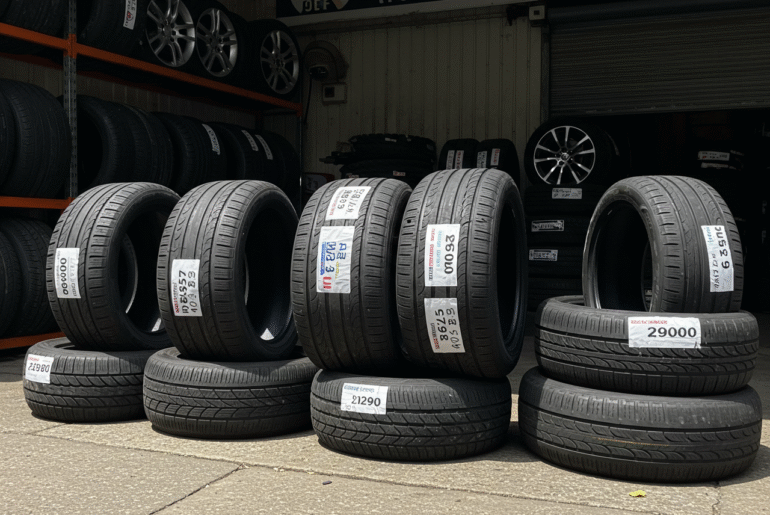This article may contain references to products or services from one or more of our advertisers or partners. We may receive compensation when you click on links to those products or services. Nonetheless, our opinions are our own.
The information presented in this article is accurate to the best of our knowledge at the time of publication. However, information is subject to change, and no guarantees are made about the continued accuracy or completeness of this content after its publication date.
Introduction
Finding the right tires is not just about looking at the prices. You need to choose tires that match your driving needs and fit your car. Important things to consider are tire size, the type of terrain you will drive on, and how well they handle different weather conditions. For instance, if you live in a cold area, winter tires might be a good choice. On the other hand, if you have a sports car, you might want performance tires. The prices of tires can vary significantly. Learning the basics of selecting tires can help you make better choices without sacrificing quality or safety. The next sections will cover the factors affecting tire costs and how to make the best decision.
Average Tire Costs and What Affects Them
Buying new tires can be challenging because there are so many brands and models available. A set of four new tires typically costs between $460 and $1,280, not including labor. The price of tires depends on several factors, like size, type, and special features such as unique tread patterns.
You should also consider additional costs like installation, balancing, and disposal fees. These can significantly impact the total price. Understanding these charges can help you budget more effectively and make smarter purchasing decisions.
Factors That Affect Tire Prices
Several factors impact tire prices. Seasonal tires, like winter and summer varieties, are designed for specific climates. Winter tires are often more expensive because they are made with specialized rubber for icy roads. In contrast, all-season tires are versatile and generally less expensive.
Durability also influences tire costs. Tires made from high-quality materials with longer tread life tend to be more expensive. However, they provide better value over time, especially for drivers who frequently use their vehicles.
Tire size is another critical cost factor. Larger tires, often used on trucks and SUVs, require more materials and are typically more expensive. By comparing performance, longevity, and price, you can find the best option for your budget.
Price Ranges by Tire Type
Understanding average price ranges can make tire shopping simpler. The table below provides a quick overview of low and high prices for each tire type:
| Type of Tire | Low Price per Tire ($) | High Price per Tire ($) |
|---|---|---|
| All-season | 49 | 873 |
| Summer | 81 | 1,486 |
| Winter | 57 | 1,311 |
| Touring | 51 | 428 |
| Terrain | 103 | 1,447 |
| Performance | 52 | 1,486 |
For example, all-terrain tires, commonly chosen by SUV owners, might cost more but can last for up to 40,000 miles. In contrast, compact car owners often prefer more affordable all-season tires. Choosing the right tires helps balance cost and driving needs.
Voted "Best Overall Budgeting App" by Forbes and WSJ
Monarch Money helps you budget, track spending, set goals, and plan your financial future—all in one app.
Get 50% OFF your first year with code MONARCHVIP
How to Choose the Right Tires
The tire-buying process becomes simpler if you follow a few straightforward steps. Start by determining the type of tire that fits your driving habits and the typical road conditions you encounter. For instance, winter tires may be ideal for snowy areas, while all-season tires are often suitable for urban driving.
Next, research prices and features from reputable stores, both locally and online. Pay attention to tread life ratings to assess long-term value. Once you find the right tires, prepare for the installation process.
Tools and Services for Tire Installation
Proper tire installation requires some necessary tools and services.
- Tire Pressure Gauge: Helps maintain proper tire inflation for safety and performance.
- Jack and Lug Wrench: Required for safely removing and installing tires.
- Alignment Services: Offered at many auto service centers, including major retailers like Walmart.
- Tire Balancing Machine: Typically operated by professionals during installation to ensure a smooth ride.
Look for seasonal sales or store discounts to save money. Checking the tread life rating can also help extend tire lifespan. Some retailers, like Discount Tire, offer payment plans to make purchasing easier.
Final Thoughts
Planning for tire costs involves understanding what influences pricing, including type, size, seasonal needs, and brand quality. Knowing average tire prices allows you to make more informed financial choices. With the right information and preparation, buyers can stay within their budgets and maintain vehicle safety. Consulting with experts at tire shops and service centers can also provide valuable guidance.
Frequently Asked Questions
How much does it cost to replace all four tires?
Replacing all four tires typically costs between $460 and $1,280, depending on factors like size, type, brand, and additional installation costs. Smaller car tires are on the lower end of the range, while larger SUV or truck tires fall on the higher end. Installation fees, taxes, and disposal charges can raise the total. Always confirm full pricing before purchase.
What factors influence tire prices?
Tire prices vary based on size, type, tread pattern, material quality, and durability. Seasonal tires, like winter models, generally cost more due to specialized rubber for specific weather conditions. Performance tires also cost more due to design features like enhanced grip or higher speed ratings. Brand reputation can also affect pricing significantly.
Yes, additional expenses like installation, balancing, alignment, and disposal fees can significantly increase the total cost of replacing tires. These services are often necessary to ensure safety and performance. Some retailers bundle services, while others charge separately. Always ask for a full cost breakdown upfront.
How can I save money when buying tires?
To reduce costs, shop during seasonal sales, compare prices online, and consider payment plans offered by some retailers. Choose tires with longer tread life for better long-term value. Look into store loyalty programs or rebates. Installation packages can sometimes help you save on extra services.

Reviewed and edited by Albert Fang.
See a typo or want to suggest an edit/revision to the content? Use the contact us form to provide feedback.
At FangWallet, we value editorial integrity and open collaboration in curating quality content for readers to enjoy. Much appreciated for the assist.
Did you like our article and find it insightful? We encourage sharing the article link with family and friends to benefit as well - better yet, sharing on social media. Thank you for the support! 🍉
Article Title: New Tire Costs and Smart Ways to Save
https://fangwallet.com/2025/07/27/new-tire-costs-and-smart-ways-to-save/The FangWallet Promise
FangWallet is an editorially independent resource - founded on breaking down challenging financial concepts for anyone to understand since 2014. While we adhere to editorial integrity, note that this post may contain references to products from our partners.
The FangWallet promise is always to have your best interest in mind and be transparent and honest about the financial picture.
Become an Insider

Subscribe to get a free daily budget planner printable to help get your money on track!
Make passive money the right way. No spam.
Editorial Disclaimer: The editorial content on this page is not provided by any of the companies mentioned. The opinions expressed here are the author's alone.
The content of this website is for informational purposes only and does not represent investment advice, or an offer or solicitation to buy or sell any security, investment, or product. Investors are encouraged to do their own due diligence, and, if necessary, consult professional advising before making any investment decisions. Investing involves a high degree of risk, and financial losses may occur including the potential loss of principal.
Source Citation References:
+ Inspo
There are no additional citations or references to note for this article at this time.












































